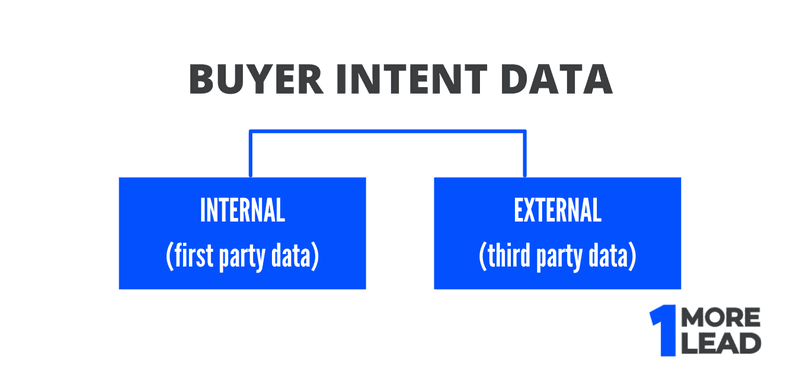
Imagine being able to recognize organizations in their buying cycle who are actively looking for a product similar to what you offer. Buyer intent data lets you do exactly that.

Only 25% of B2B organizations use buyer intent data, but it's one of the most effective ways to grow your pipeline of qualified leads.
If you are reading this article, you're probably aiming to start leveraging intent data to effectively expand your lead pipeline.
In this article, we'll explain what intent data is, how to utilize it, and where you can get it. Let’s get started!
Buyer intent data is made up of aggregated behavioral signals that allow businesses to identify buyers throughout the buying cycle.
It may sound complicated, but you are most likely to already consider it in your sales and marketing strategies.
Behavioral signals of buying intent include things like:
Actually, buyer intent data is a set of information indicating a lead, who is in their buying cycle and is about to buy your solution/product (or a competitor's solution).
Website data, off-site activity, CRM, social media data, and content consumption data are the most common sources of intent data.
Interactions with a website or a campaign can be used to evaluate engagement. Data should constantly be scored by your sales team based on how engaged your leads are.
Whether it's a chatbot conversation, time spent on your website, or the number of actions taken on your website. These behaviors are all indicative of the buyer's journey, and your sales staff should make contact at this point.
There are two types of intent data, each from a different source: Internal and External. We'll look at internal intent data as well as external intent data.

Let's take a closer look at what each of them means.
First-party intent data is another name for internal intent data. This data is acquired in-house using your marketing automation platform or if you have a web app, application logs.
The advantages of collecting intent data internally are that you'll have complete control over what and how you collect it. You can also act on it right away and tailor how this constitutes buying intent to your preferences.
Then there are third-party intent data, also known as external intent data. As the name implies, this is collected outside of your institution but can be used by your team.
Third-party intent data is obtained through IP lookups or cookies on specific websites. Since it is difficult to collect and use intent data in-house, using an external provider and licensed behavioral data is a popular way to capitalize on this valuable resource.
There are strong benefits of using Buyer Intent Data in your marketing strategy. Let’s see the benefits of it and why you should be using it!
Closing more deals is the top sales priority for 75% of businesses. Wouldn't you want to know if a lead is almost ready to buy?
Prospecting becomes easier with intent data.
Companies are researching your solution to make your sales representatives' jobs easier and faster. Because you know who is looking at which content, your team can personalize their communications with each lead.
Furthermore, third-party intent data will inform your team about how and what leads are researching. This allows you to engage with leads as soon as possible and add your solution to their list of considerations.
Getting access to B2B intent data will boost your sales team. They'll be able to prospect for SQLs in a relatively short time than it would normally take them, and they'll be able to make the most of their time.
Only 18% of marketers believe that their outbound efforts generate the highest quality leads. While cold outreach can yield results, you never know if the prospects you contact are ready to purchase.
Your sales cycle may be lengthy because most purchasers now see at least 3-5 pieces of content before attempting to engage with a sales rep and conduct additional research such as talking to colleagues or looking at vendor review sites such as Capterra.
Providing your sales team access to a source of intent data enables them to contact qualified leads earlier in their buying cycle rather than wasting so much time sending emails to unqualified leads.
Intent data can also improve the return on investment of your B2B content syndication efforts. You can see who is looking into your solution and better target your content.
Traditional lead scoring involves adding points to a lead's score when they complete specific actions.
Intent data reveals alternative options your leads take even when they aren't on your site. Based on the research on your solution, your marketing team can precisely lead score and anticipate people's buy intent.
Your sales agents can then use that information to prioritize who they contact based on how eager to buy they are.
Personalization is the foundation of successful Account-Based Marketing strategies. The most efficient strategy to optimize your ABM efforts is to lay out your buyer journey and always deliver the most relevant information to leads.
By segmenting your lists and only providing relevant content to purchase-ready leads, intent data allows you to proactively nurture leads in your campaigns. This ensures that every touchpoint in your marketing corresponds to the lead's expectations.
The connection between topics and context can be seen using intent data. You can address people's inquiries about your product or service in new content if you know what they're asking before they buy it.
These insights can be used by your marketing team to direct content generation and boost the inbound flow of leads to your website.
Only 46% of salespeople have statistical insights into their consumers' readiness to buy. This figure is modest, given that practically every sales agent would agree that this information would be extremely beneficial.
Why are so few sales teams have the access to such important data?
Calculating buyer intent, turns out, is a difficult undertaking. Initially, you must establish what is important to you and how you prioritize interactions with key decision-makers.
You must also account for who is engaging with your brand, as it is pointless to track, score, and spend time on leads who aren't a good fit for your company. You can then forecast buyer intent by collecting buying signals.
When creating intent data, you should take numerous factors into account, including recency, frequency, and engagement.
The frequency with which a prospect interacts with your content is valuable information. If you wait weeks to contact leads who have viewed your website, they will have either made a purchase decision or will have forgotten about you.
In sales, timing is crucial. According to research, the vendor who reacts or contacts the customer first receives 35-50% of the sale. Your sales staff will close more deals if they respond quickly to buyer intent and contact decision-makers at the optimal time.
Another important sign of buyer intent is frequency. If you notice a lead visiting important pages regularly (e.g., your pricing page, case studies, etc.), you can presume they're in the buying cycle.
Your sales staff will then be aware that now is an excellent moment to contact them.
You may utilize engagement as the third signal of buyer intent. Most lead scoring systems focus heavily on engagement, and the same holds true for intent data.
It's a good opportunity to contact a lead who is interacting with your content on your website, through a chatbot, or an email nurturing campaign.
In conclusion, these three considerations are all critical for generating accurate intent data. This means you can create a complete image of your potential consumer, determine when they're ready to purchase, and reach out to them with a tailored message.
Intent data will alter your prospecting and how you engage with leads. Companies that use intent data have a clear competitive advantage over their rivals. Identifying ideal buyers during their purchase cycle enables your staff to engage with leads in the most effective way.
Looking to find the perfect prospects for your business? Book a One